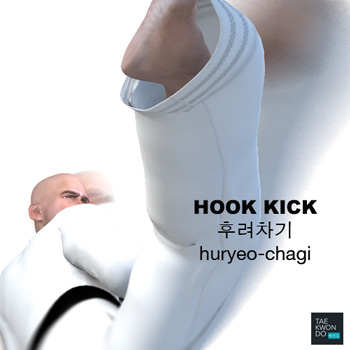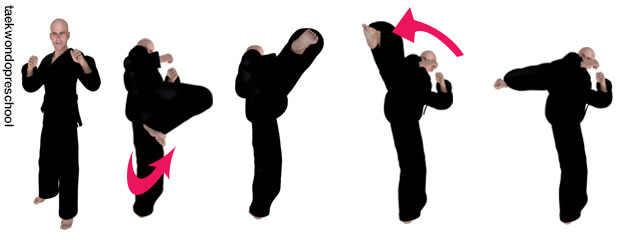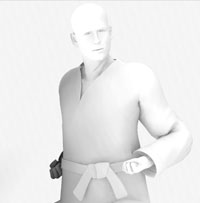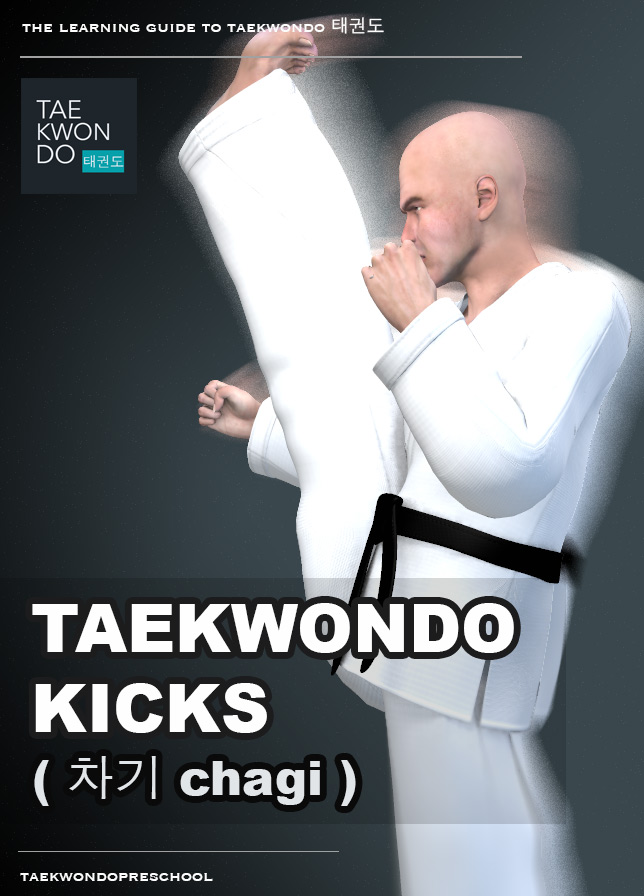Taekwondo 태권도Taekwondo Preschool
Promotion from one geup to the next can proceed rapidly in some schools, since schools often allow geup promotions every two, three, or four months. Students of geup rank learn the most basic techniques first, and then move on to more advanced techniques as they approach first dan. Many of the older and more traditional schools often take longer to allow students to test for higher ranks than newer, more contemporary schools, as they may not have the required testing intervals. View Taekwondo belt levels »

Hook Kick
후려차기 huryeo-chagi
A kick (차기 chagi) is a physical strike using the foot, leg, or knee. The striker relaxes to the extent possible during the strike, tensing the muscles of much of the body only at the time of impact, then relaxing again to recoil the striking part. Relaxation enables the strike to achieve the greatest possible velocity during travel, while rigidity at impact allows the maximum transfer of force.
Difficulty Level: Intermediate Technique: Kick ( 차기 chagi )
A less popular kick ( 차기 chagi ) traditionally, the Hook Kick ( 후려차기 huryeo-chagi ) has found increasing favour in modern taekwondo competitions and in demonstrations. This is a kick ( 차기 chagi ) that a practitioner should practice often and master. Practice is the act of rehearsing a behavior over and over, or engaging in an activity again and again, for the purpose of improving or mastering it, as in the phrase 'practice makes perfect'.
The Hook Kick ( 후려차기 huryeo-chagi ) is performed similar to a Side Kick ( 옆차기 yeop-chagi ), however the kick ( 차기 chagi ) is intentionally aimed slightly off target in the direction of the kicking foot's toes and then whipped back to the target. The Hook Kick ( 후려차기 huryeo-chagi ) can be delivered with a near-straight leg at impact, or with a hooked finish where the knee ( 무릎 mureup ) bends (snap) before impact to catch the target from behind.
Once the kicking leg is at full extension, the knee ( 무릎 mureup ) is bent and the foot snapped to the side, impacting the target with most commonly the bottom of the heel ( 뒤축 dwichuk ) as striking surface. The Hook Kick ( 후려차기 huryeo-chagi ) strikes with various surfaces including the bottom of the heel ( 뒤축 dwichuk ), back of the heel ( 뒤꿈치 dwikkumchi ) or the flat sole of the foot ( 발바닥 balbadak ).
In taekwondo tournament sparring ( 겨루기 gyeorugi ), it could be used at the resulting miss of a short Side Kick ( 옆차기 yeop-chagi ) to the head ( 머리 meoli ) or combination kick ( 차기 chagi ) while in the air, but is considered a very high level technique in said circumstances to control the leg in midair with such flexibility.

Variations of Hook Kick ( 후려차기 huryeo-chagi )
- Front Foot Whip Kick ( 앞발 후려차기 apbal-huryeo-chagi )
- Skipping Whip Kick ( 발붙여 후려차기 balbucheo-huryeo-chagi )
- Spin Kick ( 뒤후려차기 dwi-huryeo-chagi )
- Jumping Back Whip Kick ( 뛰어 뒤후려차기 ttwieo-dwi-huryeo-chagi )
- Holding Whip Kick ( 잡고 후려차기 japgo-huryeo-chagi )
- 360º Back Whip Kick ( 360도 뒤후려차기 360º dwi-huryeo-chagi )
- 540º Back Whip Kick ( 540도 뒤후려차기 540º dwi-huryeo-chagi )
Training Methods
How well one improves with training depends on several factors, such as the frequency it is engaged in, and the type of feedback that is available for improvement. If a student does not train often enough, reinforcement fades, and he or she is likely to forget what was learned.
During training, taekwondo practitioners may use various equipment and gear for practicing the kick ( 차기 chagi ). Taekwondo extensively uses the heavy bag for developing power and endurance. Powerful strikes to the heavy bag aren't recommended for inexperienced, or younger athletes, as risk of sprain, strain, or bone plate damage may adversely affect bone structures. It is highly recommended to carefully focus strikes to reduce chance of injury.
The kick ( 차기 chagi ) is best learned initially striking at the air as though there is an opponent but focusing on the form, speed, control, and technique; then moving on to soft surfaces striking punch mitts and target pads. Large heavy bags are used more for strength and endurance, while smaller targets such as punch mitts and target pads focus on faster kicking speed, timing and coordination. Target pads are useful for training mobility and accuracy on a moving target.
Difficulty of Technique
Taekwondo students of geup ranking learn the most basic techniques first, and then move on to more advanced and difficult techniques as they approach 1st Dan Black Belt. The more difficult the technique, the more practice may be needed for the purpose of improving or mastering it, as in the phrase 'practice makes perfect'. Every technique must display the requisite speed, balance, power and firmness to be realistically used as an attack or defense move.
* Please see a certified Master Instructor ( 사범님 sabeomnim ) for training. Proper guidance and instructions are needed to ensure safe training.
Promotion Tests
Students often undergo periodic testing and grading by their own Master Instructor ( 사범님 sabeomnim ) in order to advance to a higher level of recognized achievement such as a different belt color. They need to demonstrate their proficiency in the various aspects of the art such as the execution of patterns ( 품새 poomse ), which combine various techniques in specific sequences.
Hook Kick ( 후려차기 huryeo-chagi ) is a requirement for the below belt levels (Techniques vary between schools). Promotion from one belt level to the next can proceed rapidly in some schools, since schools often allow geup promotions every two, three, or four months. Students of geup rank learn the most basic techniques first, and then move on to more advanced techniques as they approach first dan black belt. View Promotion Tests »

Training Safety Precautions
Overtraining can be described as a point where a person may have a decrease in performance and plateauing as a result from failure to consistently perform at a certain level or training load exceeds their recovery capacity. They cease making progress, and can even begin to lose strength and fitness. Overtraining is also known as chronic fatigue, burnout and overstress in athletes.
It is important to note the difference between overtraining and over-reaching; over-reaching is when an athlete is undergoing hard training but with adequate recovery, overtraining however, is when an athlete is undergoing hard training without the adequate recovery. View Overtraining »
* Please see a certified Master Instructor ( 사범님 sabeomnim ) for training. Proper guidance and instructions are needed to ensure safe training.

Training Highlights Summary
The Kick ( 차기 chagi ) contains many key point highlights. There are some that are simple and straightforward but then some are complex and detailed that require repeated training to learn and master.
- strikes with the heel from the side (or the flat sole of the foot in sparring)
- intentionally aimed slightly off target in the direction of the kicking foot's toes and then whipped back to the target
- one will also try to get ones 'hip into the kick', resulting perhaps in a slight shift of weight
- mainly used to strike the jaw ( 턱 teog ) of an opponent, but is also highly effective in the temple ( 관자놀이 gwanjanoli ) region for a knockout attempt
- speed is considered one of the most important component of developing power in taekwondo and remember to concentrate the area of impact into as small an area as possible
- remember to thoroughly do some warm-up and basic stretching activities before lifting your legs too high
Strength Requirement of the Technique
Most strikes should generally be thrown with some measure of shifting body weight supporting the blow. The striker in combat should attempt to strike through the target area, not just contact the surface. Some strikes do not need as much strength as they target vulnerable areas such as the eyes ( 눈 nun ), neck ( 목 mok ) or sternum ( 흉골 hyung-gol ). The below is an approximate measurement of how much strength the strike requires from the practitioner to be effective.
Precision of Kicking ( 차기 chagi ) Technique
With proper execution opponents may be stopped with a single striking blow, which lessens the number of further strikes. Some kicks ( 차기 chagi ) can strike with more precision which will often cripple or knockout the opponent. The below is an approximate measurement of how precise the kick ( 차기 chagi ) requires from the practitioner to be effective.
Experienced practitioners learn through repetition and muscle memory when (not just how) to launch particular kicks ( 차기 chagi ), based on the circumstances they are facing.
* Please see a certified Master Instructor ( 사범님 sabeomnim ) for training. Proper guidance and instructions are needed to ensure safe training.
Risk of injury can be reduced by completing an effective warm up consisting of a heart raiser to get your pulse up, followed by sport specific dynamic stretches (stretches whilst moving). Please follow the guidance of a certified Master Instructor or trainer when doing sports related activities. Depending on the intensity of the exercise, cooling down can involve a slow jog or walk, or with lower intensities, stretching can be used. Cooling down allows the heart rate to return to its resting rate. View more information on Warming Up and Cooling Down ».
This article uses material from the Wikipedia articles "Warming Up" and "Cooling Down", which is released under the Creative Commons Attribution-Share-Alike License 3.0.
There are five tenets defined in the International Taekwondo Federation (ITF) and several more in World Taekwondo (WT).
Courtesy ( 예의 ye-ui ): "Showing courtesy to all, respecting others, having manners as well as maintaining the appropriate etiquette at all times, both within and outside the dojang (도장) (designated training area)." View Taekwondo Tenets »
RESOURCES
This article uses material from the Wikipedia article "Kick" which is released under the Creative Commons Attribution-Share-Alike License 3.0.















































